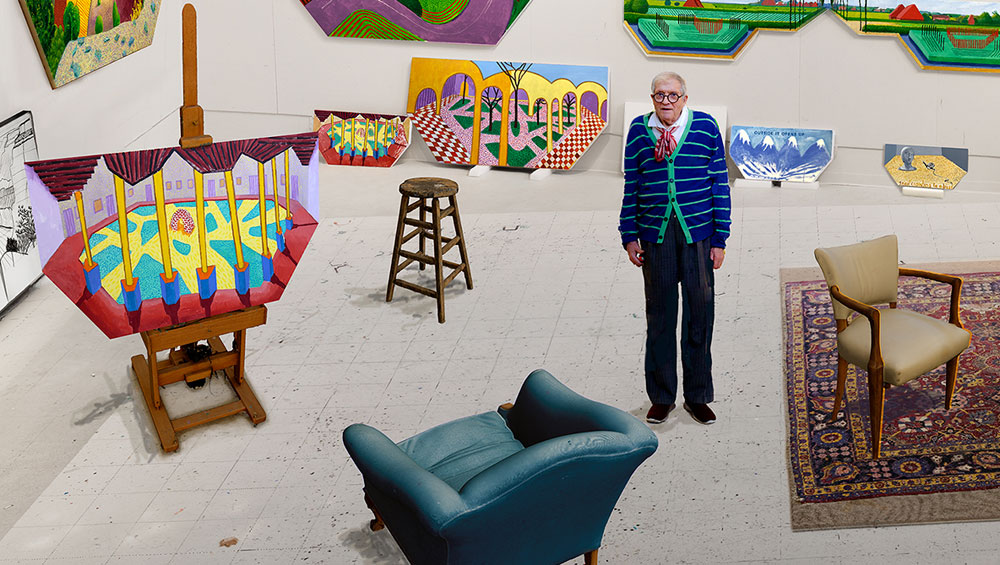
David Hockney. In the Studio, December 2017, 2017 (detail). Photograph courtesy Pace Gallery. © 2018 David Hockney.
Pace Gallery, New York
5 April – 12 May 2018
by JILL SPALDING
The timing seemed ill-judged, given that David Hockney has just bounced off the major retrospective that opened in London and then Paris before landing at the Metropolitan Museum of Art to rack up neck-to-neck attendance with the blockbuster exhibition of Michelangelo drawings that the paucity of exhibition slots had unintentionally paired it with. Turns out, there was a cogent reason for trucks to be pulling up just days later to Hockney’s Los Angeles studio to deliver fresh work to New York’s Pace gallery for a 5 April opening. A case of apples and oranges. Although the last iteration of the artist’s famous Blue Terrace exercises that led out of the Met’s show leads into the one here, Something New in Painting (and Photography) [and even Printing] introduces as advanced a pictorial vernacular as its title suggests and as jolting a reset as a slap in the face.
![Installation view of David Hockney: Something New in Painting (and Photography) [and even Printing], 510 West 25th Street, New York, NY, April 5 – May 12, 2018. Photograph courtesy Pace Gallery. © 2018 David Hockney.](/images/articles/h/082-hockney-2018/Hockney_inst_2018_vF.jpg)
Installation view of David Hockney: Something New in Painting (and Photography) [and even Printing], 510 West 25th Street, New York, NY, April 5 – May 12, 2018. Photograph courtesy Pace Gallery. © 2018 David Hockney.
It helps to have some “perspective”, so to speak, on Hockney’s lifetime pursuit of the elusive visual grail that this latest body of work is meant to resolve. Start with the trial balloons of the 1960s – what happens if multiple materials crowd the frame? If part of the canvas is left bare? If the canvas is sectioned? By then, too, Hockney was mining the old masters for western takes on perspective before and after the “pinhole” dictum imposed by the Renaissance. Some investigations persisted (light and shadow), some vanished (Flight Into Italy – Swiss Landscape, 1962, was the first and last outdoor painting to hold more than two figures).
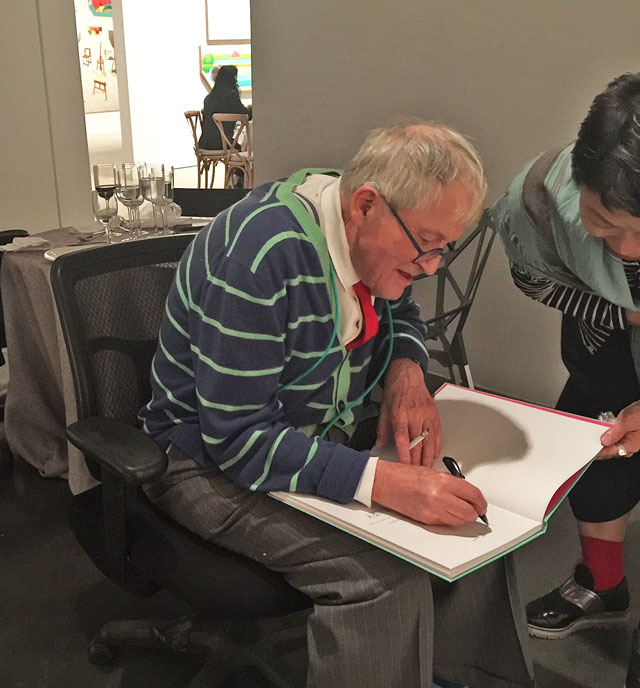
David Hockney, pen in one hand, cigarette in the other, 2018. Photograph: Jill Spalding.
Detoured by his move to Los Angeles, Hockney traded in depth for the flat magic of acrylic, the perfect material to capture light, water and infinite space – those deserts, those swimming pools, A Bigger Splash! (1967). Although so difficult to adjust once the brush struck the canvas that he had an assistant stand by to keep it wet, its translucency delivered the transparency of his liberated new life. In retrospect, albeit hugely productive, those early years in the American west were time out. Resolved to upend traditional perspective, Hockney plunged into aborted investigations with the developing tools of holograms (too wispy) and Xeroxes (too flat). “Painters have always known there is something wrong with perspective,” he would say of his attempts to re-view it. He saw the two problems as the foreground, tackled in cubism’s “where am I?”, and the vanishing point.
![Installation view of David Hockney: Something New in Painting (and Photography) [and even Printing], 510 West 25th Street, New York, NY, April 5 – May 12, 2018. Photograph courtesy Pace Gallery. © 2018 David Hockney.](/images/articles/h/082-hockney-2018/Hockney_inst_2018_vH.jpg)
Installation view of David Hockney: Something New in Painting (and Photography) [and even Printing], 510 West 25th Street, New York, NY, April 5 – May 12, 2018. Photograph courtesy Pace Gallery. © 2018 David Hockney.
To further train his eye – and “frankly, I couldn’t afford paint” – Hockney returned to drawing. By the mid-70s, he had mastered precise line with the incredibly difficult Rapidograph pen – “You can’t make a mistake” – building off the crosshatching from its tiny, sharp-point, infinite gradations of clouds, light and tangled branches. That he was keeping his eye on the prize manifested in a simultaneous search for a truer perspective from inverting planes with hot-coloured gouache: “I realised that as those spaces got deeper so did the psychological exploration.”
Another eureka moment came around 1987 after a drive with no traffic (it was Christmas) through the Gotthard tunnel, then the worlds’ longest, which found Hockney advancing eerily and seemingly forever on a pinprick of light until, upon exiting, the world burst open to a rapturously wide vista and to the flash realisation that the artist could capture absolute seeing by deploying reverse perspective.

David Hockney. A Bigger Interior with Blue Terrace and Garden, 2017. Acrylic on canvas, 48 x 96 in (121.9 cm x 243.8 cm). Photograph: Jill Spalding.
To that end, he took up the camera again, although now not for snapshots but rather to broaden the narrowed cyclopean vision that was suddenly driving the collector agenda. Open to the new possibilities of still photography, Hockney wielded the lens like a brush – first with the Polaroid camera, then the Pentax 110 – to assemble cubistic photo-collages out of overlapped views. Initially, as with the vast Polaroid “joiner” of the Grand Canyon (1982) and Kyoto’s Ryoanji Gardens (1983), he shot from one place, but the perspective in the resulting image remained frozen and the space read as a triangle. Clearly, he realised, to form a view-around rectangle, he must move. A detour to Chinese painting taught that the scroll’s “moving focus” perspective does not have a vanishing point; rather, it unfolds a landscape, reflecting how early humans, to assure safety from predators when they entered a space, swept their gaze right and left. Nature is not separate from us, as suggested pictorially by one-point western perspective: we are constantly moving through and across it. To do the same optically, the viewer must be placed inside the picture.
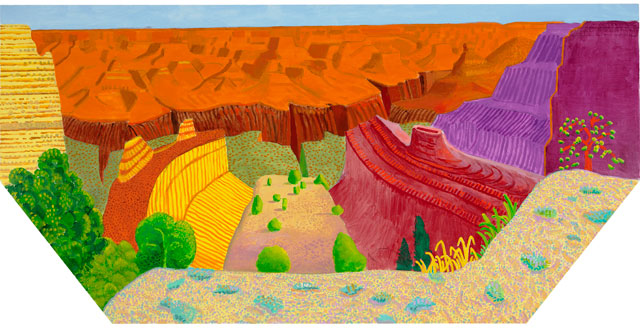
David Hockney. Grand Canyon II, 2017. Acrylic on canvas, 48 x 96 in (121.9 cm x 243.8 cm). Photograph courtesy Pace Gallery. © 2018 David Hockney.
Hockney now had three instruments trained on perspective and used each to push the envelope incrementally. Painting leapt ahead with fractured, colour-reinforced vantages that wrested movement, depth field and scenic grandeur from long country roads (those famed meanders down Mulholland Drive and the Wolds) and the optical tour de force Grand Canyon (1986), composed to skew the vantage point with a grid of 60 canvases that work the surrounding elements around and against each other.
A grand finale seemed imminent, but Hockney was not there yet and became readily sidelined. There were the portrait-series intervals when he painted any of his friends who came up to visit: and the detour investigation into camera obscura, a technique of manipulating mirrors to project an image on to a surface that can then be traced over for a slyly accurate rendering. Alleging its use by such revered masters as Jan van Eyck, Constable and Ingres, his theory stirred up an art-world brouhaha that proved an unwelcome distraction from the big search at hand, leading him to bow out in 2001 and throw out his cameras “cold turkey”.
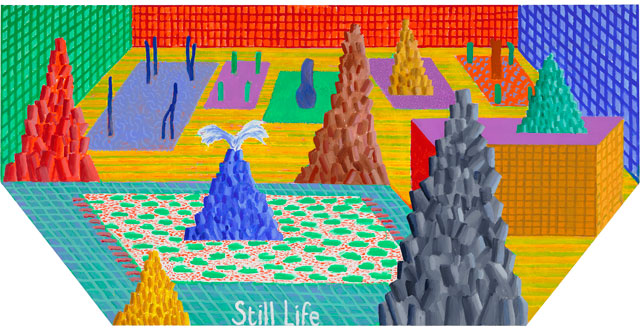
David Hockney. Still Life, 2017. Acrylic on canvas, 48 x 96 in (121.9 cm x 243.8 cm). Photograph courtesy Pace Gallery. © 2018 David Hockney.
Hockney had never been drawn to video apart from its use as a tool to record a 1983 series of delicate black-and-white portrait drawings. Their “faint lines playing against dark lines” had made them difficult to photograph for the catalogue, but a closeup taken with a video camera provided a greater contrast for reproduction – “a quality that I thought to exploit”. Rejecting photography confirmed that he was done with pinhole perspective; “those claustrophobically constricting edges – the only thing a photograph can do well is capture another flat surface”.
Returning to Yorkshire, Hockney plunged back into painting for that irreplaceable emotion of draughtsmanship – eye to arm to hand. To rein in the only classical medium not yet mastered, he made a short series of watercolours – brief only in output since it took almost a year to coral the technique to his purpose of widening the literal and figurative field. More visits to Yorkshire – a close friend was dying, and later his mother – pushed perspective every which way in roiling paintings of hills, fields and valleys that tumbled over each other as the car wound around them.
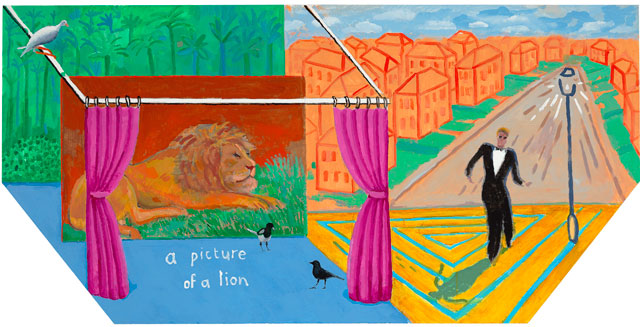
David Hockney. A Picture of a Lion, 2017. Acrylic on canvas, 48 x 96 in (121.9 cm x 243.8 cm). Photograph courtesy Pace Gallery. © 2018 David Hockney.
Still not satisfied, Hockney headed back west and turned outwards. Catapulting investigations into quantum mechanics had already brought him to understand time and space as an enveloping continuum and of matter existing in two places at once. Now, breakthrough technologies were rendering theory visible. The iPad and iPhone, initially amusements to be explored with a child’s delight in new toys, led to the discovery that, manipulated with the artist’s accumulated skills, small drawings could be worked three-dimensionally, rendered proportionately large, and printed in editions without losing texture or, as Hockney would put it, “quality”.
Drawn to the challenge of visual contrast, Hockney returned to Yorkshire, for the inflections of weather that Los Angeles can’t supply. Throughout long months at Woldgate waiting for the seasons to change, he did nothing but draw. Quick iPad sketches ceded to intense charcoal drawings – both as an end (glorious, the outsized Arrival of Spring series of massive trees filtering the shimmer of summer and winter’s dying light!), and as a means (to refine his ideas on perspective by walking the eye through multiple vantages of the Wolds as the seasons shut and opened the light along each of the vistas.) Still pushing perception, Hockney turned even seemingly dead ends to advantage; on returning to Woldgate to find the large trees sawn through, he mourned for two days and then drew them, too – elevating the felled limbs into a contemplation of man’s inhumanity to nature and a pick-up-sticks exercise in amputated perspective.
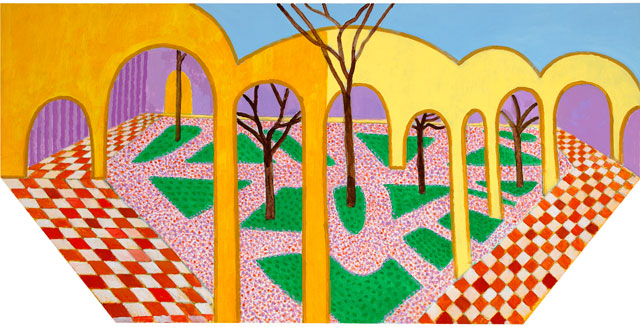
David Hockney. Walk Around the Alcazar, 2017. Acrylic on canvas, 36 x 72 in (91.4 cm x 182.9 cm). Photograph courtesy Pace Gallery. © 2018 David Hockney.
Still not quite there, he forged on. Reverting to the camera, but now fully its master, he experimented with photographing scattered chairs, tables and friends individually to create varied vantages and then painting them all on one canvas – “true-perspective” still lifes assembled from many layers of information as, until now, only the human eye has been able to do. Those who saw this groundbreaking show at the LA Louver Gallery recall almost every work in it.
One problem still nagged – something was still diluting the focus. Could it be his long-cherished rectangle? Clearly the corners must go! It helped that Hockney had shaped canvas long before – he may have been the first – with Tea Painting (1961). The purpose then was one of strut and show – to make his work pop for the pop art moment soon rejected – but now, in 2017, realising that formatting could serve his higher purpose, Hockney ordered up a clutch of variously shaped wooden frames and went feverishly to work.
He revisited his beloved old masters for their takes on western perspective and, one by one, inverted them. That spring, invited to the studio that attaches like a pod to the famed house-of-primary-colours in North Hollywood, I found him, ringed in smoke and profound silence, sketching out on a large sheet of drawing paper with a spaghetti-thin twig of charcoal, a scene depicting, of all things, Fra Angelico’s Annunciation. Buffaloed by what seemed an unlikely conversion, I sat with him in silence for perhaps 20 minutes watching the roughly sketched image morph into a radically reversed view of established perspective.
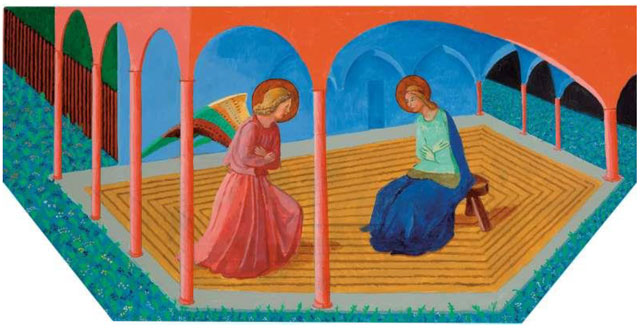
David Hockney. Annunciation II, after Fra Angelico from The Brass Tacks Triptych, 2017. Acrylic on canvas 48 x 96 in (121.9 cm x 243.8 cm). Photograph courtesy Pace Gallery. © 2018 David Hockney.
I realised that what had thrown me was not the religiosity but the inversion: the cloistered scene of the announced miracle was receding out. Casting around the studio to see where this was going, I saw some hexagonal frames propped here and there and, tacked to the wall, a small reproduction of the original Fra Angelico. I now understood that, like the other images selected from master painters Hockney admired, this reworking of an early Renaissance icon served less as homage than as resolution to the elusive problem of How to See. Of how to actually perceive, in the complex way that an eye on either side of the nose fuses two views of the same image into a three-dimensional one. Chopping off one corner of the canvas, went his theory, forces the eye to the other; chopping off two corners should swirl the eye in many directions at once – the genetic way of fully seeing that the rectangle and pinhole perspective of Renaissance painting had wiped from our brains, much as adulthood erases the multi-dimensional representations in the drawings of children. There was no way at this stage to know how much closer to visual truth a shaped painting could take us. So much of Hockney’s earlier work, after all, had skewed perspective, with torqued roads, reduced skies and chairs that flared outward.
On 5 April 2018, one of those dates now forever etched in memory, the world saw that he had done it. Walking into the Pace gallery in downtown Manhattan, I experienced a jolt that was in every way physical. If there can be a flash forward, this was it. Were these paintings? Were they even canvases? Or were they, indeed, like that slab that had opened director Stanley Kubrick’s equally astounding 2001, a new truth?
Hockney considers these trybrids the penultimate breakthrough. All those roads to enlightenment – the sectioned paintings, landscape paintings, Polaroids, and digital combines – myriad reversals of perspective enforced by a masterful manipulation of challenging techniques – have finally upended the false model. That receding tunnel now widened; that frozen still-life mandate of table, bowl of fruit, vase with flowers now fully dimensional and, as with the “diva flowers”, in active dialogue, the way our two eyes might read them at first glance.
What has pushed these shaped paintings forward into the irretrievable synthesis of a theory resolved is evidenced by the show’s title. The “something new” as experienced here is the combined use of lens, digital printing and the configured canvas to rework background and foreground, space and time, light and shadow into the “true” perspective actually seen by the eye on either side of your nose as you walk through a place that exists before, after and while you are walking through it.
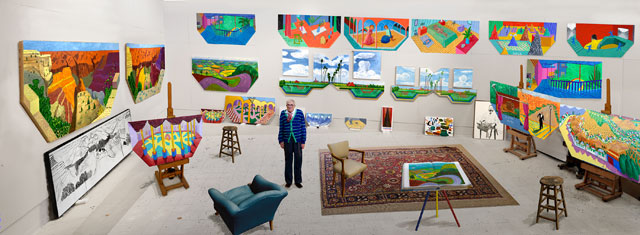
David Hockney. In the Studio, December 2017, 2017. Photographic drawing printed on seven sheets of paper, mounted on seven sheets of Dibond sheet size: 109-1/2 x 42-3/4 in, each 9ft 1-1/2 x 24ft 11-1/4 in (278.1 cm x 760.1 cm), overall installation dimensions. Photograph courtesy Pace Gallery. © 2018 David Hockney.
The show’s centrepiece, In the Studio (December 2017) – ur Hockney in that it is at once comprehensive and detailed – is a mural-length compendium of all the shaped paintings in the show as scanned on to three walls of his studio to halo the artist with a triumphant: “I’ve cracked it!” It is a wonderful thing, as much object as painting, and will hopefully take up residence for future generations to embrace in a major museum.
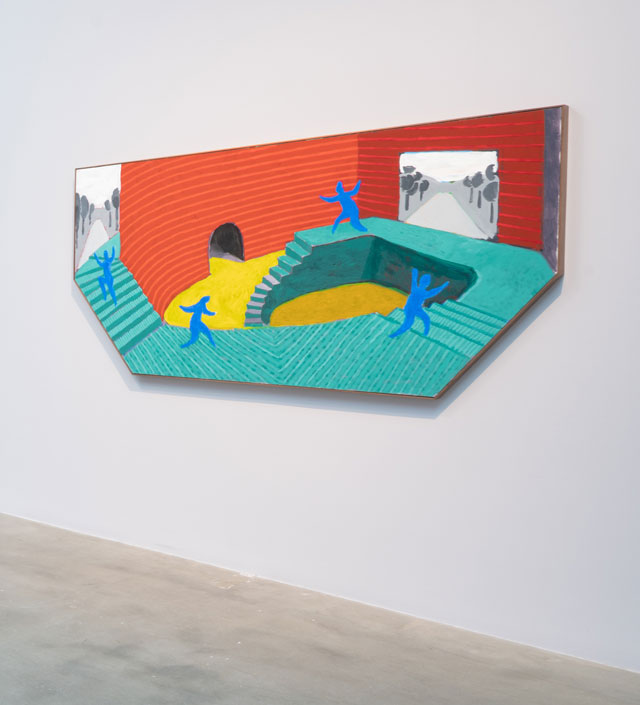
David Hockney. Hither and Dither, 2017. Acrylic on canvas, 48 x 96 in (121.9 cm x 243.8 cm). Installation view. Photograph courtesy Pace Gallery. © 2018 David Hockney.
There are other delights. Hither and Dither (2017) relegates western perspective to the dustbin by foregrounding two ash-grey receding road scenes with the fauvist-coloured whither and thither of steps, stripes and dancers. The newly shaped Grand Canyon ll (2017) tugs the viewer into both its recesses and its depth. Inasmuch as Hockney is among the very few living artists who understands landscape as essence, each work here presents at once as perspective and portrait. Underscoring the conflation, at the opening the close friends whom the artist has drawn over the years seemed an integral part of the paintings they were looking at. There was Maurice Payne, in front of Inside It Opens Up As Well (2018); Gregory Evans by Garrowby Hill (2017); Dagny Corcoran contemplating Focus Moving (2017).
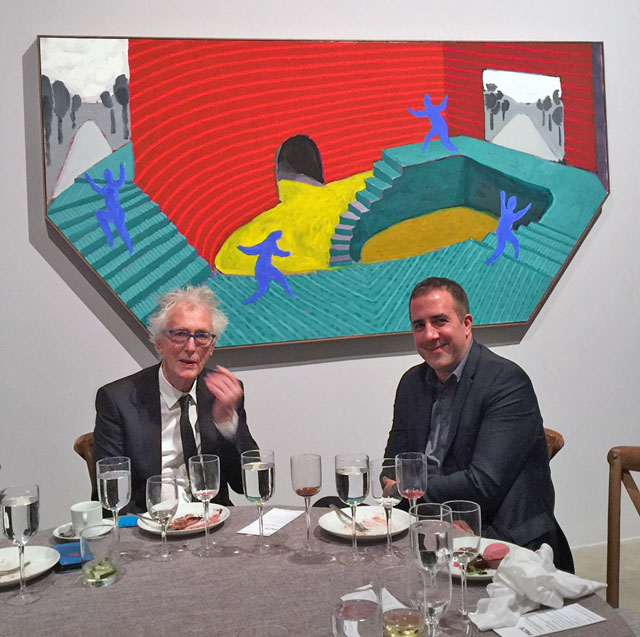
David Hockney’s long-time friend Maurice Payne (left), subject of many portraits, in front of Hither and Dither. Photograph: Jill Spalding.
My personal favourite, in the American parlance, is Tall Dutch Trees After Hobbema (Useful Knowledge) 2017. It is not only the boldest departure from a wall painting, but the closest answer to where, in the hands of a seer, drawn perspective can go. Stand before it as though you are sitting in the convertible that Hockney drives, with Wagner blaring, along Mulholland Drive to the beach. The “car’s hood” has obscured the road in front of you, moving the notorious vanishing point up to the clouds floating in space-time, then out to the views in each of the “side windows”, and then left and right on the Chinese painting horizontal to the images reflected back in the “side mirrors” – both breaking up perspective in the real way a car’s interior construction does, and reunifying it in the multidimensional way the brain does.
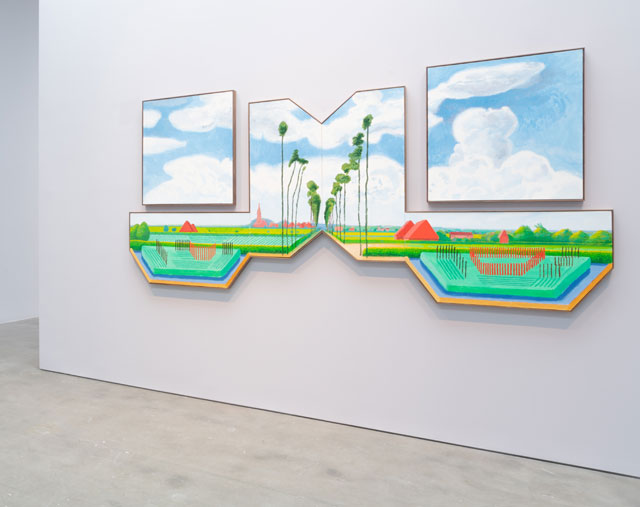
David Hockney. Tall Dutch Trees After Hobbema (Useful Knowledge), 2017. Acrylic on six canvases (two canvases: 36 x 36 in, four joined canvases: 24 x 48 in) overall installation dimensions 64 x 144 in (162.6 cm x 365.8 cm). Photograph courtesy Pace Gallery. © 2018 David Hockney.
Hockney still hasn’t figured out what to call this new process beyond – “a combination of photographs and drawing and printing, with each bringing out the best in the other”. It is a tribute to his mastery that the lasting impact is one of painting – painting in the heroic church and court manner of a George Bellini and Charles Le Brun, but advanced to provide a wider way of seeing by the reverse perspective wrested over a lifetime from close investigations with painting, photography and, yes, “even printing”.
It remains to be seen if Hockney will consider this revolutionary body of work “case closed”. Those who know him to be the seeker-eternal anticipate a next chapter. Meanwhile, these masterworks are not to be missed. Before they disappear into waiting-list collections, view them at the very least on your Hockney-endorsed iPad. So aesthetically ravishing and intellectually complex is this brave new world of seeing as to intrigue even the practised viewer for some time.